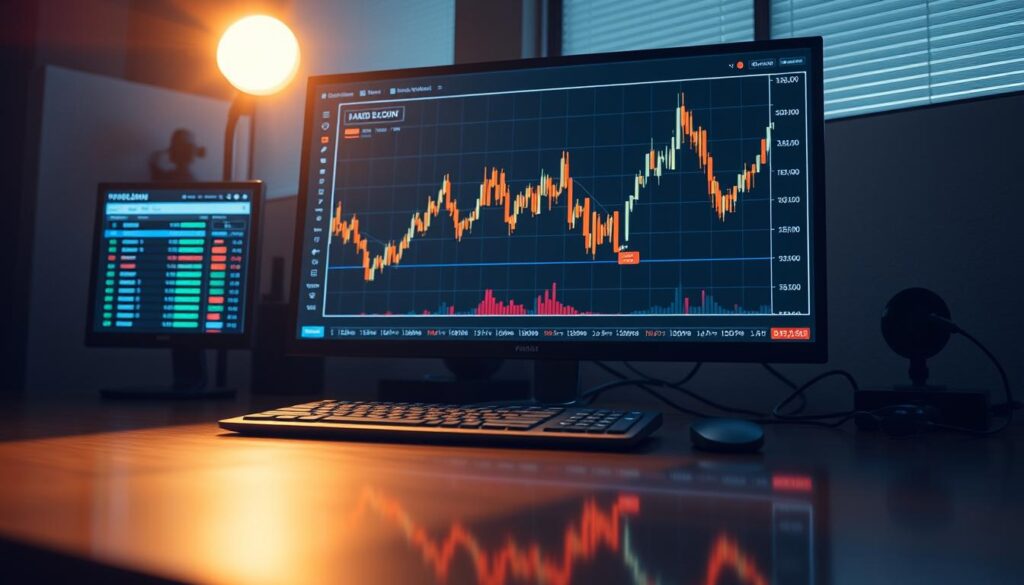Cryptocurrency trading demands sophisticated analytical tools to navigate volatile markets. Technical analysis provides traders with critical insights into market trends, price movements, and potential trading opportunities. These crypto indicators help investors make data-driven decisions in an ecosystem characterized by rapid price fluctuations.
Successful technical analysis in cryptocurrency trading requires understanding complex market signals. Traders utilize various indicators to decode price patterns, assess market sentiment, and predict potential price movements. These tools transform raw market data into actionable trading strategies.
Professional cryptocurrency traders rely on technical analysis indicators as their primary decision-making framework. By interpreting charts, tracking momentum, and analyzing historical price data, investors can develop strategic approaches to digital asset trading.
Key Takeaways
- Technical analysis helps decode cryptocurrency market trends
- Multiple indicators provide comprehensive market insights
- Data-driven strategies reduce trading risks
- Understanding market psychology is crucial
- Continuous learning enhances trading performance
Understanding Technical Analysis in Cryptocurrency Markets
Crypto market analysis represents a critical skill for investors navigating the complex digital asset landscape. Technical analysis provides traders with powerful tools to interpret market movements and make informed trading decisions.
Successful cryptocurrency trading requires a deep understanding of multiple analytical approaches. Traders leverage various strategies to decode market dynamics and predict potential price movements.
Fundamental vs Technical Analysis
Cryptocurrency investors typically choose between two primary analytical methods:
- Fundamental Analysis: Evaluates intrinsic project value
- Technical Analysis: Studies price patterns and market psychology
While fundamental analysis examines underlying project fundamentals, technical analysis focuses on statistical trends derived from trading activity and price charts.
The Role of Market Psychology
Market psychology plays a crucial role in cryptocurrency trading. Emotional responses like fear and greed can significantly impact price movements, creating unique opportunities for strategic traders.
- Sentiment tracking helps predict potential market shifts
- Psychological indicators reveal trader behavior patterns
- Emotional intelligence enhances trading decisions
Time Frames and Their Importance
Trading time frames provide critical context for cryptocurrency market analysis. Different time perspectives offer unique insights into market trends:
- Short-term (minutes to hours): Day trading strategies
- Medium-term (days to weeks): Swing trading approaches
- Long-term (months to years): Investment positioning
Understanding these time frames allows traders to develop more nuanced and effective trading strategies in the volatile crypto market.
Essential Tools for Crypto Technical Analysis
Cryptocurrency traders rely on sophisticated crypto trading tools to navigate the complex digital asset markets. Technical analysis software has become an essential companion for both novice and experienced investors seeking to make informed trading decisions.
The landscape of charting platforms offers traders a wide range of powerful capabilities. Selecting the right technical analysis software can significantly impact a trader’s ability to interpret market trends and execute strategic trades.
- TradingView: A popular web-based charting platform with advanced visualization tools
- MetaTrader 4/5: Robust trading platforms supporting multiple cryptocurrency exchanges
- CryptoCompare: Comprehensive market data and analysis dashboard
Key features to consider in crypto trading tools include:
- Real-time price tracking
- Advanced charting capabilities
- Technical indicator libraries
- Historical data analysis
- Custom alert systems
Professional traders often utilize multiple charting platforms to cross-reference market signals and validate their technical analysis. The right combination of tools can provide a competitive edge in the fast-moving cryptocurrency markets.
When evaluating technical analysis software, traders should prioritize platforms that offer:
- Intuitive user interface
- Comprehensive market coverage
- Reliable data sources
- Mobile and desktop compatibility
By investing in high-quality crypto trading tools, investors can enhance their market analysis, improve decision-making processes, and potentially increase their trading performance in the volatile cryptocurrency landscape.
Moving Averages and Their Application in Crypto Trading
Cryptocurrency traders rely on technical analysis tools to navigate volatile markets. Moving averages stand out as crucial indicators for understanding price trends and making informed trading decisions. These powerful analytical tools help traders identify market momentum and potential trend reversals.
Moving averages smooth out price data by creating a constantly updated average price. They come in different forms, each providing unique insights into market behavior:
- Track short-term and long-term price movements
- Identify potential trend directions
- Generate trading signals for crypto investors
Simple Moving Average (SMA)
The Simple Moving Average calculates the average price over a specific number of periods. Traders use SMA to understand the underlying price trend by averaging out price fluctuations. SMA provides a clear visual representation of price movement across different time frames.
Exponential Moving Average (EMA)
Exponential Moving Average gives more weight to recent price data. EMA responds faster to recent price changes compared to SMA, making it particularly useful in fast-moving cryptocurrency markets. Traders appreciate EMA for its ability to highlight recent price trends more quickly.
Moving Average Convergence Divergence (MACD)
MACD combines multiple moving averages to create a powerful trading indicator. It helps traders identify momentum, trend direction, and potential buy or sell signals. By comparing short-term and long-term moving averages, MACD offers deep insights into market dynamics.
- Reveals trend strength
- Indicates potential trend reversals
- Helps traders make strategic decisions
Cryptocurrency traders can leverage these moving average tools to develop robust trading strategies and manage market volatility effectively.
Relative Strength Index (RSI) for Cryptocurrency Markets

The Relative Strength Index (RSI) stands as a powerful momentum oscillator that helps cryptocurrency traders analyze market trends and potential price movements. This technical analysis tool measures the magnitude of recent price changes to evaluate overbought and oversold levels in trading markets.
Traders use the RSI indicator to gain insights into market momentum and potential trend reversals. The indicator operates on a scale from 0 to 100, with specific key zones that signal different market conditions:
- Below 30: Indicates potential oversold conditions
- Above 70: Suggests potential overbought levels
- Between 30-70: Represents neutral market momentum
Cryptocurrency traders leverage the RSI to make informed trading decisions. When the RSI reaches extreme levels, it can signal potential price corrections or trend changes. Experienced traders often combine the RSI with other technical analysis tools to validate their market predictions.
Understanding the RSI’s nuances requires practice and strategic interpretation. While the momentum oscillator provides valuable market insights, it should not be the sole basis for trading decisions. Smart traders integrate multiple indicators and consider broader market context when developing their cryptocurrency trading strategies.
Integrating Technical Analysis Indicators in Cryptocurrency Trading
Cryptocurrency trading demands a strategic approach to technical analysis. Successful traders leverage indicator combinations and sophisticated trading dashboards to navigate the volatile digital asset markets. Understanding how to effectively integrate multiple technical indicators can significantly improve trading decisions and risk management.
Traders can enhance their cryptocurrency trading performance by carefully selecting and combining technical indicators. The right approach helps minimize false signals and improve overall trading accuracy.
Popular Indicator Combinations
Effective indicator combinations create powerful trading signals by cross-referencing different market perspectives. Some proven strategies include:
- Moving Average + Relative Strength Index (RSI)
- MACD + Bollinger Bands
- Stochastic Oscillator + Volume Indicators
Setting Up Your Trading Dashboard
A well-designed trading dashboard is crucial for cryptocurrency traders. Key components should include:
- Real-time price charts
- Multiple timeframe indicators
- Customizable technical analysis tools
Risk Management Strategies
Implementing robust risk management is essential in cryptocurrency trading. Technical indicators play a critical role in developing protective strategies:
| Strategy | Indicator Usage | Risk Mitigation |
|---|---|---|
| Stop-Loss Placement | Support/Resistance Levels | Limit potential losses |
| Position Sizing | Volatility Indicators | Control portfolio exposure |
| Entry/Exit Timing | Momentum Oscillators | Optimize trade execution |
Successful cryptocurrency trading requires continuous learning and adaptability. By mastering indicator combinations, developing a robust trading dashboard, and implementing strong risk management techniques, traders can navigate the complex digital asset markets with greater confidence.
Bollinger Bands in Crypto Trading

Bollinger Bands stand as a powerful volatility indicator in cryptocurrency trading, offering traders unique insights into market dynamics. These bands create price channels that help investors understand potential price movements and market sentiment.
The indicator consists of three lines: a middle band (typically a 20-day simple moving average) and two outer bands that expand and contract based on market volatility. Traders use Bollinger Bands to identify:
- Potential price breakouts
- Market volatility levels
- Possible trend reversals
- Overbought or oversold conditions
When the bands squeeze together, it signals low volatility and suggests a potential significant price movement is imminent. Conversely, wide bands indicate high market volatility in cryptocurrency markets.
Crypto traders often combine Bollinger Bands with other technical analysis tools to enhance their trading strategies. The bands work particularly well when integrated with momentum indicators or trend-following strategies.
Successful implementation requires understanding how these price channels react in different market conditions. Experienced traders use Bollinger Bands to make informed decisions about entry and exit points in volatile crypto markets.
Volume Analysis and Trading Volume Indicators
Trading volume stands as a critical metric in cryptocurrency technical analysis, providing deep insights into market dynamics and potential price movements. Investors and traders rely on volume indicators to gauge market sentiment, confirm trend strength, and identify potential reversals in the volatile crypto landscape.
Understanding trading volume helps traders make more informed decisions by revealing the underlying strength behind price movements. When price and volume work in harmony, they can signal significant market trends and potential trading opportunities.
On-Balance Volume (OBV) Indicator
The OBV indicator offers a powerful tool for volume price analysis in cryptocurrency markets. This momentum indicator combines price and volume to create a cumulative line that tracks buying and selling pressure. Traders use the OBV indicator to:
- Confirm existing price trends
- Detect potential trend reversals
- Identify divergences between price and volume
- Assess market momentum
Volume Price Analysis Strategies
Volume price analysis allows traders to interpret market dynamics by examining the relationship between trading volume and price movements. Key strategies include:
- Trend Confirmation: Strong volume accompanying price movements validates the trend’s strength
- Divergence Detection: Identifying disconnects between volume and price can signal potential market shifts
- Support and Resistance: Volume levels can help determine critical price zones
Successful cryptocurrency traders integrate volume analysis into their technical analysis toolkit, using these indicators to make more strategic trading decisions in the dynamic digital asset markets.
Fibonacci Retracement in Digital Asset Trading

Fibonacci retracement stands as a powerful technical analysis tool that cryptocurrency traders leverage to identify potential support and resistance levels during price movements. This mathematical approach helps traders predict possible price pullbacks and understand market psychology.
The core of Fibonacci retracement lies in key percentage levels derived from the Fibonacci sequence. These levels typically include:
- 23.6% retracement
- 38.2% retracement
- 50% retracement
- 61.8% retracement
- 76.4% retracement
Traders use these price retracements to anticipate potential trend reversals or continuation patterns. When applying Fibonacci retracement to cryptocurrency charts, traders draw these levels between significant price points, typically a major swing high and low.
Understanding the nuances of Fibonacci retracement requires practice and integration with other technical indicators. While not infallible, these levels provide valuable insights into potential market turning points and help traders make more informed decisions.
To effectively use Fibonacci retracement in digital asset trading, consider these strategies:
- Identify major price swings in the cryptocurrency’s trend
- Draw Fibonacci retracement levels between significant points
- Look for confluence with other support and resistance levels
- Confirm signals with additional technical indicators
Successful cryptocurrency traders recognize that Fibonacci retracement is not a standalone strategy but a complementary tool in a comprehensive technical analysis approach.
Stochastic Oscillator for Crypto Market Timing
The Stochastic Oscillator is a powerful momentum indicator that helps cryptocurrency traders identify potential market entry and exit points. This technical analysis tool measures the relationship between an asset’s closing price and its price range over a specific period, providing insights into market timing and potential trend reversals.
Traders use the Stochastic Oscillator to detect overbought and oversold conditions in cryptocurrency markets. By analyzing price momentum, investors can make more informed decisions about when to buy or sell digital assets.
Understanding Fast and Slow Stochastic
The Stochastic Oscillator comes in two primary variations:
- Fast Stochastic: Provides more sensitive and immediate signals
- Slow Stochastic: Offers smoother, more filtered momentum readings
Interpreting Overbought and Oversold Signals
Cryptocurrency traders typically use the following guidelines for interpreting Stochastic Oscillator signals:
- Readings above 80 indicate overbought conditions
- Readings below 20 suggest oversold conditions
- Crossovers between %K and %D lines signal potential trend changes
Successful market timing with the Stochastic Oscillator requires practice and understanding of its nuanced signals in different market environments.
Price Action Trading in Cryptocurrency
Price action trading represents a powerful approach to analyzing cryptocurrency markets by focusing directly on price movements. Traders using this method examine raw price data to make informed trading decisions without relying heavily on complex technical indicators.

The core of price action trading involves understanding key visual elements that reveal market sentiment and potential future movements. Traders learn to recognize specific candlestick patterns that signal potential trend reversals or continuations in cryptocurrency markets.
- Identify critical support and resistance levels
- Analyze candlestick patterns for market insights
- Interpret price movements without complex indicators
- Recognize trend strength and potential reversals
Successful price action trading requires deep understanding of market psychology. Traders must develop skills to read subtle price movements and distinguish between normal market fluctuations and significant trend changes.
| Price Action Technique | Key Characteristics | Trading Significance |
|---|---|---|
| Candlestick Patterns | Visual representation of price action | Predict potential market reversals |
| Support/Resistance Levels | Key price zones of market interest | Identify entry and exit points |
| Trend Analysis | Directional price movement | Determine market momentum |
Cryptocurrency traders can leverage price action trading by combining visual pattern recognition with disciplined risk management. Understanding support and resistance zones helps traders make more calculated decisions in the volatile digital asset markets.
Chart Patterns and Formation Analysis
Cryptocurrency traders rely on chart patterns as critical tools for understanding market dynamics and predicting potential price movements. These visual representations help investors identify strategic entry and exit points in by revealing underlying market psychology and trend potential.
Chart patterns are divided into two primary categories: continuation patterns and reversal patterns. Each type provides unique insights into potential market behavior, enabling traders to make more informed decisions.
Understanding Continuation Patterns
Continuation patterns signal that an existing market trend is likely to persist. These chart patterns typically indicate a temporary pause before the previous trend resumes. Key continuation patterns include:
- Bullish and bearish flags
- Pennants
- Triangles
- Rectangles
Exploring Reversal Patterns
Reversal patterns suggest that the current market trend might change direction. These powerful chart patterns can help traders anticipate potential trend inversions. Some prominent reversal patterns are:
- Head and shoulders
- Double tops and bottoms
- Inverse head and shoulders
- Triple tops and bottoms
Successful traders understand that no chart pattern guarantees absolute market prediction. Combining pattern analysis with volume indicators and other technical analysis tools can enhance trading strategies and risk management.
Using Multiple Time Frame Analysis
Multiple time frame analysis stands as a critical technique for cryptocurrency traders seeking to develop a robust crypto trading strategy. By examining price movements across different time intervals, traders gain a more comprehensive understanding of market dynamics.
The core principle of multiple time frame analysis involves evaluating price action and trends across various timeframes – from minutes to weeks. This approach helps traders confirm trends and minimize potential false signals that might occur on a single time frame.
- Short-term time frames (1-5 minutes): Ideal for entry and exit points
- Medium-term time frames (1-4 hours): Reveal intermediate market trends
- Long-term time frames (daily-weekly): Provide broader market perspective
Trend confirmation becomes more reliable when multiple time frames demonstrate consistent directional movement. Traders can use this technique to validate potential trading opportunities and reduce risk in volatile crypto markets.
| Time Frame | Analysis Purpose | Trading Relevance |
|---|---|---|
| 1-5 minutes | Precise Entry/Exit | Day Trading |
| 1-4 hours | Trend Validation | Swing Trading |
| Daily-Weekly | Market Direction | Long-Term Investment |
By integrating multiple time frame analysis into your crypto trading strategy, you can develop a more nuanced and informed approach to market analysis. This method helps traders make more confident decisions by reducing emotional trading and enhancing technical insights.
Momentum Indicators for Crypto Markets
Cryptocurrency traders rely on momentum indicators to gauge the speed and strength of price movements. These powerful tools help investors understand market dynamics beyond simple price charts. Momentum indicators provide critical insights into potential trend reversals and market sentiment.
Traders seeking to enhance their technical analysis skills can leverage two key momentum indicators: Rate of Change (ROC) and Williams %R. These tools offer unique perspectives on market momentum in volatile cryptocurrency trading environments.
Understanding Rate of Change (ROC)
Rate of Change is a momentum indicator that measures the percentage change in price between the current price and a price from a specified number of periods ago. Crypto traders use ROC to:
- Identify rapid price acceleration
- Detect potential trend reversals
- Measure the velocity of price movements
When analyzing cryptocurrency charts on platforms like Cryptohopper, traders can apply ROC to understand market momentum more effectively.
Exploring Williams %R Indicator
Williams %R is another critical momentum indicator that helps traders identify overbought and oversold conditions in cryptocurrency markets. This oscillator ranges from 0 to -100, providing insights into market sentiment.
| Williams %R Value | Market Interpretation |
|---|---|
| 0 to -20 | Potentially Overbought |
| -80 to -100 | Potentially Oversold |
Traders can integrate Williams %R with other technical analysis tools from resources like crypto market analysis platforms to develop more robust trading strategies.
Remember that momentum indicators are most effective when used in conjunction with other technical analysis tools and should not be relied upon exclusively for trading decisions.
Advanced Technical Analysis Strategies
Advanced technical analysis has transformed cryptocurrency trading through sophisticated algorithmic trading techniques and cutting-edge machine learning technologies. Traders now leverage complex computational methods to gain deeper market insights beyond traditional indicator analysis.
Key advanced strategies in cryptocurrency markets include:
- Algorithmic trading systems that execute trades automatically
- Machine learning predictive models for market trend identification
- Sentiment analysis using artificial intelligence
- Complex pattern recognition algorithms
Implementing advanced technical analysis requires understanding intricate market dynamics. Traders utilize sophisticated software that can process massive datasets, identifying subtle trading opportunities invisible to human analysts.
The integration of machine learning in cryptocurrency trading has revolutionized market prediction strategies. These advanced techniques analyze multiple data points simultaneously, providing more accurate trend forecasts and risk assessments.
| Strategy | Key Features | Potential Benefit |
|---|---|---|
| Algorithmic Trading | Automated Trade Execution | Reduced Emotional Decision Making |
| Machine Learning Models | Predictive Pattern Recognition | Enhanced Market Trend Prediction |
| Sentiment Analysis | Social Media & News Tracking | Real-time Market Sentiment Insights |
Professional cryptocurrency traders recognize that advanced technical analysis is not just about tools but understanding their strategic application. Continuous learning and adaptation remain crucial in this rapidly evolving digital asset landscape.
Real-Time Market Analysis Tools and Platforms
Cryptocurrency traders rely on advanced real-time analysis platforms to make informed decisions in the volatile digital asset markets. TradingView and CoinBase Pro stand out as premier crypto trading platforms that provide comprehensive market data feeds and sophisticated charting tools. These platforms enable traders to track price movements, analyze technical indicators, and execute trades with precision.
Mobile applications have revolutionized how traders interact with cryptocurrency markets. Apps like Binance, Crypto.com, and Delta Investment Tracker offer powerful real-time analysis capabilities directly from smartphones. Traders can monitor multiple cryptocurrencies, set price alerts, and access advanced technical analysis tools while on the go, ensuring they never miss critical market opportunities.
Selecting the right market analysis tool depends on individual trading strategies and preferences. Professional traders often utilize multiple platforms to cross-reference data and validate signals. Key considerations include data accuracy, speed of market data feeds, technical analysis features, user interface, and compatibility with different cryptocurrency exchanges. Advanced platforms like MetaTrader 5 and professional Bloomberg terminals provide sophisticated traders with in-depth market insights and analytical capabilities.
Successful cryptocurrency trading requires continuous learning and adaptability. Traders should invest time in understanding different real-time analysis tools, exploring their unique features, and developing a personalized approach to market analysis. Integrating multiple platforms and staying updated with the latest technological developments can significantly enhance trading performance in the dynamic cryptocurrency ecosystem.
FAQ
What are the most important technical analysis indicators for cryptocurrency trading?
The most crucial technical analysis indicators for cryptocurrency trading include Moving Averages (Simple and Exponential), Relative Strength Index (RSI), Bollinger Bands, MACD (Moving Average Convergence Divergence), and Stochastic Oscillator. These indicators help traders identify trends, momentum, volatility, and potential entry and exit points in the volatile crypto market.
How do I choose the right time frame for cryptocurrency technical analysis?
Selecting the right time frame depends on your trading strategy. Day traders typically use shorter time frames (1-minute to 1-hour charts), while swing traders and long-term investors prefer daily, weekly, or monthly charts. Multiple time frame analysis can provide a more comprehensive view of market trends and help confirm trading signals.
What is the difference between fundamental and technical analysis in crypto trading?
Fundamental analysis focuses on evaluating a cryptocurrency’s intrinsic value by examining factors like technology, team, adoption, and market potential. Technical analysis, in contrast, analyzes price movements, trading volumes, and chart patterns to predict future price action based on historical market data and statistical indicators.
How reliable are technical indicators in the cryptocurrency market?
Technical indicators are helpful but not infallible, especially in the highly volatile cryptocurrency market. No single indicator provides guaranteed results. Experienced traders typically combine multiple indicators and use them alongside risk management strategies to make more informed trading decisions.
What is the Relative Strength Index (RSI), and how do I use it in crypto trading?
The Relative Strength Index (RSI) is a momentum oscillator that measures the speed and change of price movements. It ranges from 0 to 100, with readings above 70 considered overbought and below 30 considered oversold. Traders use RSI to identify potential trend reversals, confirm price trends, and spot divergences in cryptocurrency price action.
Can technical analysis help manage risk in cryptocurrency trading?
Yes, technical analysis is a critical tool for risk management in cryptocurrency trading. Indicators help traders set stop-loss levels, identify potential support and resistance zones, and understand market volatility. By using tools like Bollinger Bands and volume analysis, traders can make more informed decisions about entry, exit, and position sizing.
What are the best platforms for cryptocurrency technical analysis?
Popular platforms for crypto technical analysis include TradingView, Binance, Coinbase Pro, BitMEX, and Coinigy. These platforms offer advanced charting tools, multiple indicators, real-time data, and customizable dashboards that help traders perform comprehensive technical analysis.
How important is volume analysis in cryptocurrency trading?
Volume analysis is crucial in cryptocurrency trading as it confirms price movements and provides insights into market sentiment. Indicators like On-Balance Volume (OBV) help traders understand the strength of price trends, potential reversals, and the overall market momentum by analyzing the relationship between price and trading volume.
What is price action trading in cryptocurrency markets?
Price action trading is a technical analysis method that focuses on analyzing raw price movements without relying heavily on traditional indicators. Traders study candlestick patterns, support and resistance levels, and trend lines to make trading decisions based on the pure price movement of a cryptocurrency.
How can I improve my technical analysis skills in cryptocurrency trading?
To improve technical analysis skills, traders should: practice continuous learning, use demo trading accounts, attend webinars and courses, follow experienced traders, study market psychology, practice backtesting strategies, and maintain a disciplined approach to trading while managing risk effectively.


No comments yet